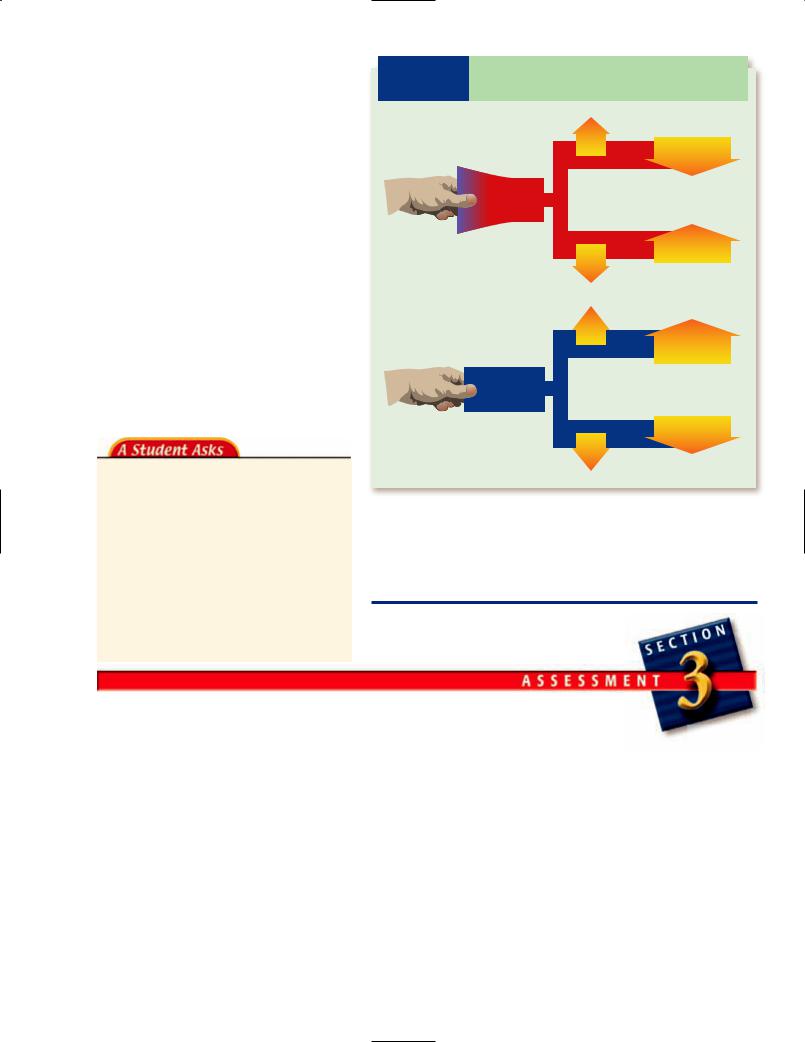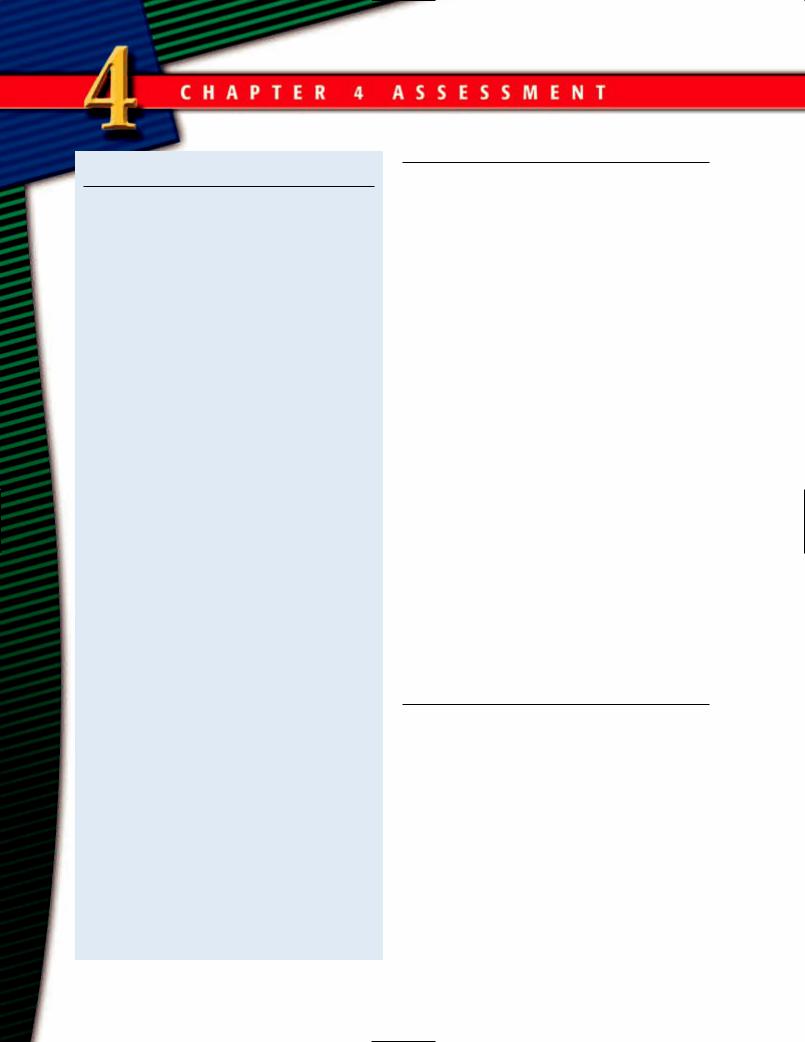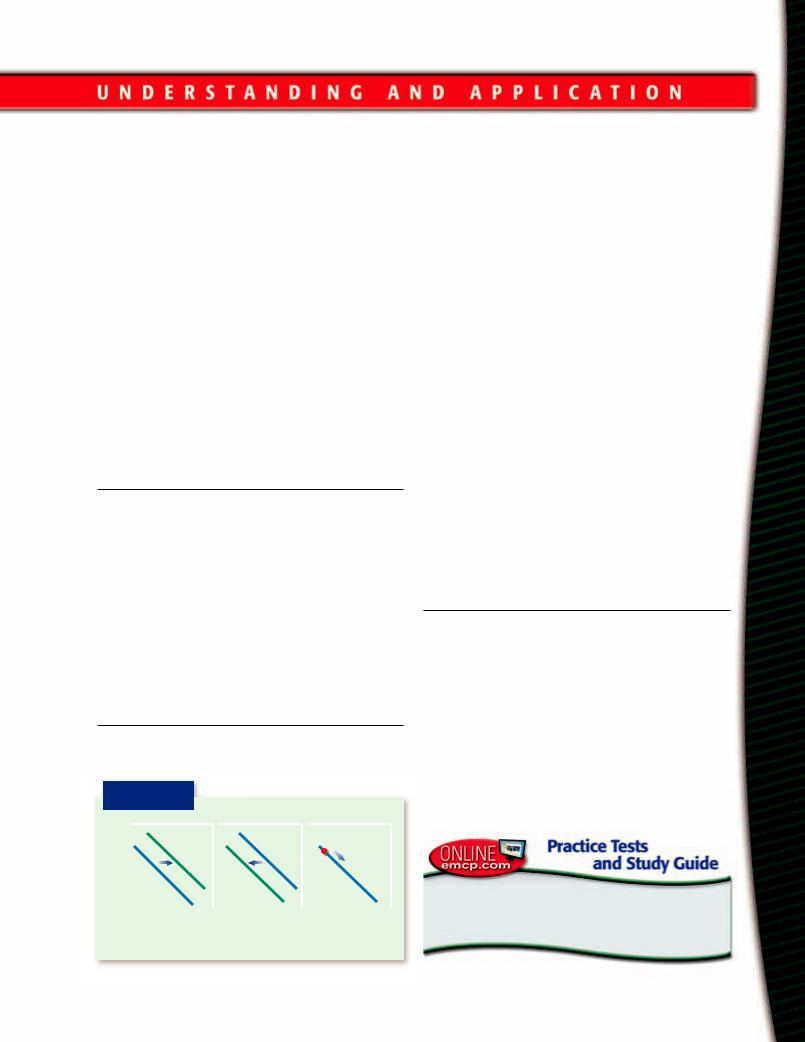
Economics_-_New_Ways_of_Thinking
.pdf
Demand for Oil
In recent years, China’s demand for oil has been rising. Two reasons: First, about 2.5 million cars are added to China’s roads every
year. Second, the industrial demand for oil has been rising because China’s
economy has been rapidly growing.
As China’s demand for oil rises, what will happen to the world demand for oil?
Although you won’t study the topic of price until a later chapter, what do you think China’s rising demand for oil will do to the price for gasoline you pay at the pump?
In contrast, a particular soft drink (say Sprite) has many substitutes (Fresca, Mountain Dew, etc.). Therefore, if the price of Sprite rises, we would expect the quanity demanded to fall greatly, because people have many other soft drinks they can choose. Is the demand for a particular soft drink more likely to be elastic or inelastic? The answer is elastic, because the more substitutes there are for a good, the more likely people will buy a lot fewer of the item if the price rises.
Luxuries Versus Necessities
Luxury goods (luxuries) are goods that people feel they do not need to survive. For example, a $70,000 car would be a luxury good for most people. Necessary goods (necessities), in contrast, are goods that people feel they need to survive. Heart medicine may be a necessity for some people. Food is a necessity for everyone.
Generally speaking, if the price of a necessity, such as food, increases, people cannot cut back much on the quantity demanded. (They need a certain amount of food to live.) However, if the price of a luxury good increases, people are more able to cut back on the quantity demanded. Between the two types of goods, luxuries and necessities, the demand for luxuries tends to be elastic; the demand for necessities is more likely to be inelastic.
Percentage of Income Spent on the Good
Claire has a monthly income of $2,000. Of this amount, she spends $10 on magazines and $400 on dinners at restaurants. In percentage terms, she spends one-half of 1 percent of her monthly income on magazines and 20 percent of her monthly income on dinners at restaurants. Suppose the price of magazines and the price of dinners at restaurants both double. What will Claire be more likely to cut back on, the number of magazines she buys or the number of dinners at restaurants?
She will probably reduce the number of dinners at restaurants, don’t you think? Claire will feel this price change more strongly because it affects a larger percentage of her income. She may shrug off a doubling in the price of magazines, on which she spends only one-half of 1 percent of her income, but she is less likely to shrug off a doubling in the price of dinners at restaurants, on which she spends 20 percent.
In short, buyers are more responsive to price changes for goods on which they spend a larger percentage of their income. In these cases, the demand is likely to be elastic. Whereas, the demand for goods on which consumers spend a small percentage of their income is more likely to be inelastic.
Time
As time passes, buyers have greater opportunities to change quantity demanded in response to a price change. If the price of electricity went up today and you knew about it, you probably would not change your consumption of electricity much today. By three months from today, though, you would probably have changed it more. As time passes, you have more chances to change your consumption by finding substitutes (natural gas), changing your lifestyle (buying more blankets and turning down the thermostat at night), and similar actions. The less time you have to respond to a price change in a good, the more likely it is that your demand for that good is going to be inelastic.
104 Chapter 4 Demand

An Important Relationship
Between Elasticity and Total
Revenue
Demand is elastic for one good and inelastic for another good. Does it matter? As you just read, it can matter to you as an individual, and it definitely matters to the sellers of goods. In particular, it matters to a seller’s total revenue (money sellers receive for selling their goods). To see how elasticity of demand relates to a business’s total revenue, let’s consider four cases in detail. The cases look at both elastic and inelastic goods and what happens to each when the price rises, and when the price falls.
•Case 1: Elastic Demand and a Price Increase
Javier currently sells 100 basketballs a
week at a price of $20 each. His total revenue (price × quanity) per week is $2,000. Suppose Javier raises the price of his basketballs to $22 each, a 10 percent increase in price. As a result, the quantity demanded falls from 100 to 75, a 25 percent reduction. The demand is elastic because the change in quantity demanded (25%) is greater than the change in price (10%). What happened to Javier’s total revenue at the new price and quantity demanded? It is $1,650: the new price ($22) multiplied by the number of basketballs sold (75).
Notice that if demand is elastic, a price increase will lead to a decline in total revenue. Even though he raised the price, Javier’s total revenue went down, from $2,000 to $1,650. An important lesson here is that an increase in price does not always bring about an increase in total revenue.
Elastic demand Price increase
Total revenue decrease
•Case 2: Elastic Demand and a Price Decrease
In case 2, as in case 1, demand is elastic. This time, however, Javier lowers the price of his basketballs from $20 to $18, a
he Bureau of Labor Statistics T(BLS) is an agency within the
U.S. Department of Labor. The agency collects data on prices
in the economy. To see whether consumer prices are rising, falling, or remaining constant, go to the BLS Web site at www.emcp.net/prices. Once there, click on “Inflation & Consumer Spending.” Next, scroll down the page until you see “Consumer Price Index (CPI).” The CPI is a measure of the prices of the goods and services purchased by consumers. Have prices risen, fallen, or remained constant in the last month reported? If prices have risen or fallen, by what percentage have they risen or fallen?
10 percent reduction in price. We know that if price falls, quantity demanded will rise. Also, if demand is elastic, the percentage change in quantity demanded is greater than the percentage change in price. Suppose quantity demanded rises from 100 to 130, a 30 percent increase. Total revenue at the new, lower price ($18) and higher quantity demanded (130) is $2,340. Thus, if demand is elastic and price is decreased, total revenue will increase.
Elastic demand Price decrease
Total revenue increase
•Case 3: Inelastic Demand and a Price Increase
Now let’s assume that the demand for basketballs is inelastic, rather than elastic, as it was in cases 1 and 2. Suppose Javier raises the price of his basketballs to $22 each, a 10 percent increase in price. If demand is inelastic, the percentage change in quantity demanded must fall by less than the percentage rise in price. Suppose the quantity demanded falls from 100 to 95, a 5 percent reduction.
Javier’s total revenue at the new price and quantity demanded is $2,090, which
Section 3 Elasticity of Demand 105

Who’s ?
Rockin’ with “Elasticity of Demand”?
Rock stars need to know more than how to write and play
music. They also need to know about elasticity of demand. In fact, a large part of their earnings will depend on whether they know about elasticity of demand.
Suppose you are a rock star. You write songs, record them, and spend 150 days each year on the road performing. Let’s say that tonight you will be performing in Chicago. The auditorium there seats
30,000 people. Do you earn more income if all 30,000 seats are sold or if only 20,000 seats are sold?
This question seems a little silly. It seems obvious that you would be better off if you sold more tickets than fewer tickets. Certainly 30,000 would be better than 20,000, wouldn’t it?
“You can’t always get what you want
But if you try sometimes You just might find You’ll get what you need”
—THE RoLLING STONES
The obvious answer here is not necessarily correct. The answer really depends on an understanding of elasticity of demand. Let’s say that to sell all 30,000 seats, the
price per ticket has to be $30. At this ticket price, total revenue, which is the number of tickets sold times the price per ticket, is $900,000.
If the demand for your Chicago performance is inelastic, a higher ticket price will actually raise total revenue. (Remember: Inelastic demand + Price increase = Increase in total revenue.) Suppose you raise the ticket price
to $50. At this higher price you will not sell as many tickets as you sold when the price was $30 per ticket. Let’s say you sell only 20,000 tickets. You have not “sold out” the auditorium, but it doesn’t matter. At a price of $50 per ticket and 20,000 seats sold, total revenue is $1 mil- lion—or $100,000 more than it was when you sold out the auditorium.*
Is a sold-out auditorium, then, better than an auditorium that is not sold out? Usually you would think so, but an understanding of elasticity of demand informs us that it may be better to sell fewer tickets at a higher price than to sell more tickets at a lower price. Who would have thought it?
1. You may not become a rock star,
but you may run your own business someday. Explain why it will be important for you to understand elasticity of demand.
2. What basic economic concept that you learned in Chapter 1 is expressed by the Rolling Stones’ lyrics on this page?
*This description assumes that only one ticket price, $30 or $50, can be charged. If more than one ticket price can be charged, then some seats may be sold for $30, some for $40, some for $50, and so on.
is the new price ($22) multiplied by the number of basketballs sold (95). Notice that if demand is inelastic, a price increase will lead to an increase in total revenue. Javier’s total revenue went from
$2,000 to $2,090 when he increased the price of basketballs from $20 to $22.
Inelastic demand Price increase Total revenue increase
106 Chapter 4 Demand

•Case 4: Inelastic Demand and a Price Decrease
Demand is again inelastic, but Javier now lowers the price of his basketballs from $20 to $18, a 10 percent reduction in price. We know that if demand is inelastic, the percentage change in quantity demanded is less than the percentage change in price. Suppose quantity demanded rises from 100 to 105, a 5 percent increase. Total revenue at the new, lower price ($18) and higher quantity demanded (105) is $1,890. Thus, if demand is inelastic and price decreases, total revenue will decrease.
Inelastic demand Price decrease Total revenue decrease
See Exhibit 4-6 for a summary of the four types of relationships between elasticity and revenue.
QUESTION: Most people seem to think that if a seller raises the price, the seller’s total revenue will automatically rise. But it isn’t always true, is it?
ANSWER: No, it isn’t always true. If demand is inelastic (case 3), then a higher price will lead to a higher total revenue, but if demand is elastic (case
E X H I B I T 4-6 Relationship of Elasticity
of Demand to Total Revenue
If |
Price |
Then |
Total revenue |
|
|||
|
|
Elastic demand
If |
Price |
Then |
Total revenue |
|
|
||
|
|
|
|
Price |
|
If |
Then |
Total revenue |
Inelastic demand
If |
Then |
Total revenue |
|
||
|
Price |
|
If demand is elastic, price and total revenue move in opposite directions: as price goes up, total revenue goes down, and as price goes down, total revenue goes up. If demand is inelastic, price and total revenue move in the same direction: as price goes up, total revenue goes up, and as price goes down, total revenue goes down.
Defining Terms
1.Define:
a.elasticity of demand
b.unit-elastic demand
c.inelastic demand
d.elastic demand
Reviewing Facts and
Concepts
2.Does an increase in price necessarily bring about a higher total revenue?
3.The price of a good rises from $4 to$4.50, and as a result, total revenue falls
from $400 to $350. Is the demand for the good elastic, inelastic, or unitelastic?
4.Good A has 10 substitutes, and good B has 20 substitutes. The demand is more likely to be elastic for which good? Explain your answer.
Critical Thinking
5.How is the law of demand
(a) similar to and (b) dif-
ferent from elasticity of demand?
Applying Economic
Concepts
6.A hotel chain advertises its hotels as “The Best Hotels You Can Find Anywhere.” Does this ad have anything to do with elasticity of demand? If so, what?
Section 3 Elasticity of Demand 107

Chapter Summary
Be sure you know and remember the following key points from the chapter sections.
Section 1
Demand is the willingness and ability of buyers to purchase different quantities of a good at different prices during a specific time period.
A market is any place where people come together to buy and sell goods and services. There are two sides to a market—demand and supply.
The law of demand says that price and quantity demanded move in opposite directions.
A demand curve graphically represents the law of demand.
Section 2
An increase in demand for a good causes the demand curve to shift to the right.
A decrease in demand causes a leftward shift in the demand curve.
A change in demand may be caused by changes in income, people’s preferences, price of related goods, number of buyers, and future price expectations.
A change in price is what causes quantity demanded to change.
Section 3
Elasticity of demand deals with the relationship between price and quantity demanded.
Demand is elastic when quantity demanded changes by a greater percentage than price.
Demand is inelastic when quantity demanded changes by a smaller percentage than price.
Elasticity of demand is affected by available substitutes, whether the good is a luxury or necessity, percentage of income spent on the good, and time.
Economics Vocabulary
To reinforce your knowledge of the key terms in this chapter, fill in the following blanks on a separate piece of paper with the appropriate word or phrase.
1. A(n) ______ is any place where people come together to buy and sell goods or services.
2.If, as income rises, demand for a good falls, then that good is a(n) ______ good.
3. According to the law of demand, as the price of a good rises, the ______ of the good falls.
4.According to the ______, price and quantity demanded are inversely related.
5. According to the ______, as a person consumes additional units of a good, eventually the utility gained from each additional unit of the good decreases.
6.Demand is ______ if the percentage change in quantity demanded is less than the percentage change in price.
7.A downward-sloping demand curve is the graphic representation of the ______.
8.For a(n) ______ good, the demand increases as income rises and falls as income falls.
9.If, as the price of good X rises, the demand for Y increases, then X and Y are ______.
10.When demand is ______, the percentage change in quantity demanded is the same as the percentage change in price.
Understanding the Main Ideas
Write answers to the following questions to review the main ideas in this chapter.
1.Margarine and butter are substitutes. What happens to the demand for margarine as the price of butter rises?
2.Explain what happens to the demand curve for apples as a consequence of each of the following.
a.More people begin to prefer apples to oranges.
b.The price of peaches rises (peaches are a substitute for apples).
c.People’s income rises (apples are a normal good).
108 Chapter 4 Demand

3.“Sellers always prefer higher to lower prices.” Do you agree or disagree? Explain your answer.
4.In each of the following, identify whether the demand is elastic, inelastic, or unit-elastic.
a.The price of apples rises 10 percent as the quantity demanded of apples falls 20 percent.
b.The price of cars falls 5 percent as the quantity demanded of cars rises 10 percent.
c.The price of computers falls 10 percent as the quantity demanded of computers rises 10 percent.
5.State whether total revenue rises or falls in each of the following situations.
a.Demand is elastic and price increases.
b.Demand is inelastic and price decreases.
c.Demand is elastic and price decreases.
d.Demand is inelastic and price increases.
Doing the Math
Do the calculations necessary to solve the following problems.
1.If the percentage change in price is 12 percent and the percentage change in quantity demanded is 7 percent, what is the elasticity of demand equal to?
2.The price falls from $10 to $9.50, and the quantity demanded rises from 100 units to 110 units. What does total revenue equal at the lower price?
Working with Graphs and Charts
Use Exhibit 4-7 to answer questions 1 through 3. (P Price and Qd Quantity demanded)
E X H I B I T 4-7
|
|
|
|
|
A |
P |
D2 |
|
D1 |
|
B |
|
|
|
|
||
|
D1 |
|
D2 |
|
D |
0 |
|
|
|
|
|
|
|
Qd |
|
|
|
|
|
|
|
|
|
|
(a) |
|
(b) |
|
(c) |
1.What does Exhibit 4-7(a) represent?
2.What does Exhibit 4-7(b) represent?
3.What does Exhibit 4-7(c) represent?
E X H I B I T 4-8
(a) |
P |
|
TR |
Demand is |
|
. |
|
|
|||||||
|
P |
|
|
|
|
|
|
(b) |
|
TR |
|
Demand is |
|
. |
|
|
|||||||
(c) |
P |
|
TR |
|
|
|
|
|
Demand is |
|
. |
||||
|
|
||||||
|
P = Price |
TR = Total revenue |
|
|
|
||
4.In Exhibit 4-8, a downward-pointing arrow (↓)
means a decrease, an upward-pointing arrow (↑) means an increase, and a bar (—) over a variable means the variable remains constant (unchanged). Fill in the blanks for parts (a) through (c).
Solving Economic Problems
Use your thinking skills and the information you learned in this chapter to find a solution to the following problem.
1.Application. Income in the economy is expected to grow over the next few years. You are thinking about buying stock in a company. Is it better to buy stock in a company that produces a normal, inferior, or neutral good? Explain your answer.
Go to www.emcp.net/economics and choose Economics: New Ways of Thinking, Chapter 4, if you need more help in preparing for the chapter test.
Chapter 4 Demand 109

Why It Matters
Just as a coin has two sides, so does a market. A coin has heads and tails; a market has a buying side and a selling
side. The previous chapter discussed demand, which is the buying side of the market. This chapter discusses supply, the selling side.
In your life, you will be both buyer and seller. You will buy many goods, and you will also sell some goods. You will certainly end up selling a resource— your labor. In Chapter 4 we learned about you as a buyer. In this chapter, we will have the chance to learn about you as a seller.
110

The following events occurred one day in April.
7:04 A.M. Tara has young twin boys, Dave and Quentin. She has tried repeatedly to get both Dave and Quentin to behave better than they have been behaving. Yesterday she promised
that she would take them to a movie if they behaved better. Dave ended up behaving a lot better, but Quentin behaved only slightly better. Right now she is asking Quentin why his behav-
ior didn’t improve as much as his brother’s.
•What does a concept like “elasticity of supply” have to do with the twins?
9:10 A.M. Georgia and Tom are sitting on a train that is traveling from East Hampton, New York, into downtown Manhattan. Georgia is reading an article about taxes
in the newspaper. It seems that the government wants to place a tax on the production of cigarettes. For every cigarette pack produced, the government wants cigarette manufacturers to pay a $2 tax. Georgia tells Tom about
the article. “What do you think of that?” she asks. Tom responds, “I think that tax is going to end up reducing the supply of cigarettes.”
• Will the tax reduce the supply of cigarettes?
11:03 A.M. Angie owns a small oil company in Texas. She believes the price of a barrel of crude oil will be higher in three months than it is today. She is thinking about not selling her current oil supply until the oil price goes up. She knows she will lose the interest on the oil revenue she would have if she sold the oil now, but thinks that the higher price in three months might more than compensate for lost interest.
• Would you advise Angie to wait until later to sell her oil?
2:38 P.M. Frank and Pete are having coffee at their local Starbuck’s. Frank owns a construction company, and Pete is his business manager. Frank says, “I’m not sure how many more people will want to work for us if we pay a higher wage. No matter how much money we offer, people just don’t want to work in construction the way they once did.” Pete just says, “I don’t know. Money is a powerful motivator.”
• Will more people want to work in the construction industry if Frank increases the wage rate (dollars per hour) he pays his employees?
111

Understanding
Supply
Focus Questions
What is supply?
Are all supply curves upward sloping?
What is the difference between a supply schedule and a supply curve?
Key Terms
supply
law of supply direct relationship quantity supplied supply schedule supply curve
supply
The willingness and ability of sellers to produce and offer to sell different quantities of a good at different prices during a specific time period.
law of supply
A law stating that as the price of a good increases, the quantity supplied of the good increases, and as the price of a good decreases, the quantity supplied of the good decreases.
direct relationship
A relationship between two factors in which the factors move in the same direction. For example, as one factor rises, the other rises, too.
What Is Supply?
Like the word demand, the word supply has a specific meaning in economics. It refers to the willingness and ability of sellers to produce and offer to sell different quantities of a good at different prices during a specific time period. The supply of a good or service requires both a supplier’s willingness and ability to produce and sell. Willingness to produce and sell means that the person wants or desires to produce and sell the good. Ability to produce and sell means that the person is capable of producing and selling the good.
 Jackie is willing to build and sell wooden chairs, but unfortunately she doesn’t know how to build a chair. In other words, she has the willingness but not the ability. Outcome: Jackie will not supply chairs.
Jackie is willing to build and sell wooden chairs, but unfortunately she doesn’t know how to build a chair. In other words, she has the willingness but not the ability. Outcome: Jackie will not supply chairs.
What Does the Law
of Supply Say?
Suppose you are a supplier, or producer, of TV sets, and the price of a set rises from $300 to $400. Would you want to supply more or
fewer TV sets at the higher price? Most people would say more. If you did, you instinctively understand the law of supply, which says that as the price of a good increases, the quantity supplied of the good increases, and as the price of a good decreases, the quantity supplied of the good decreases. In other words, price and quantity supplied move in the same direction. This direct relationship can be shown in symbols:
Law of Supply
If P ↑ then Qs ↑ If P↓ then Qs↓
(where P price and Qs quantity supplied)
When economists use the word supply, they mean something different from what they mean when they use the words quantity supplied. Again, supply refers to the willingness and ability of sellers to produce and offer to sell different quantities of a good at different prices. For example, a supply of new houses in the housing market means that firms are currently willing and able to produce and offer to sell new houses.
112 Chapter 5 Supply

Are ?
You Nicer to Nice People?
Business firms supply cars, clothes, food, computers, and
much more. The quantity of each good or service they supply depends on price. According to the law of supply, the higher the price, the greater the quantity supplied. In other words, the higher the price of notebook paper, the greater the quantity supplied of notebook paper.
Do you think the law of supply might apply to personal, as well as business, situations? Do you think people might behave differently toward others depending on the reactions to their emotions and behavior? Let’s look at some examples of one “product” that people can supply to a greater or lesser degree: niceness.
Wouldn’t you say that people can supply different amounts of niceness? Think about your own behavior: You can be very nice to a person, moderately nice, a little
nice, or not nice at all. What determines how much niceness you supply to people? (In other words, why are you nicer to some people than to others?)
One factor that may determine how nice you are to someone is how much someone “pays” you to be nice. It may be a stretch, but think of yourself as selling niceness,
in much the same way you might think of yourself selling shoes, T-shirts, corn, or computers. The quantity of each item you supply depends on how much the buyer pays you.
If people want to buy niceness from you, what kind of payment will they offer? A person could come up to you and say, “I will pay you $100 if you will be nice to me,” but usually things don’t work that way. People
buy, and therefore pay for, niceness not with the currency of dollars and cents but with the currency of niceness. In other words, the nicer they are to you, the more they are paying you to be nice to them.
Suppose a person can pay three prices of niceness: the very-nice price (high price), the moderately nice price, and the little-nice price (low price). Now consider two persons, Caprioli and Turen. Caprioli pays you the very-nice price, and Turen pays you the little-nice price. Will you be nicer to Caprioli, who pays you the higher price, or to Turen, who pays you the lower price?
If you answer that you will be nicer to Caprioli, you are admitting that you will supply a greater quantity of niceness to the person who pays you more to be nice. You have found the law of supply in your behavior. Again, you are nicer to those persons who pay you more (in the currency of niceness) to
be nice.
Do you think that when it comes to the
quantity supplied of niceness, most people behave in a manner consistent with the law of supply?
Quantity supplied refers to the number of units of a good produced and offered for sale at a specific price. Let’s say that a seller will produce and offer to sell five hamburgers when the price is $2 each. Five is the quantity supplied at this price. As you work your way through this chapter, you will see why it is important to know the difference between supply and quantity supplied.
The Law of Supply in
Numbers and Pictures
We can represent the law of supply in numbers, just as we did with the law of demand. The law of supply states that as price rises, quantity supplied rises. Exhibit 5- 1(a) shows such a relationship. As the price goes up from $1 to $2 to $3 to $4, the quantity supplied goes up from 10 to 20 to 30 to
quantity supplied
The number of units of a good produced and offered for sale at a specific price.
Section 1 Understanding Supply 113
